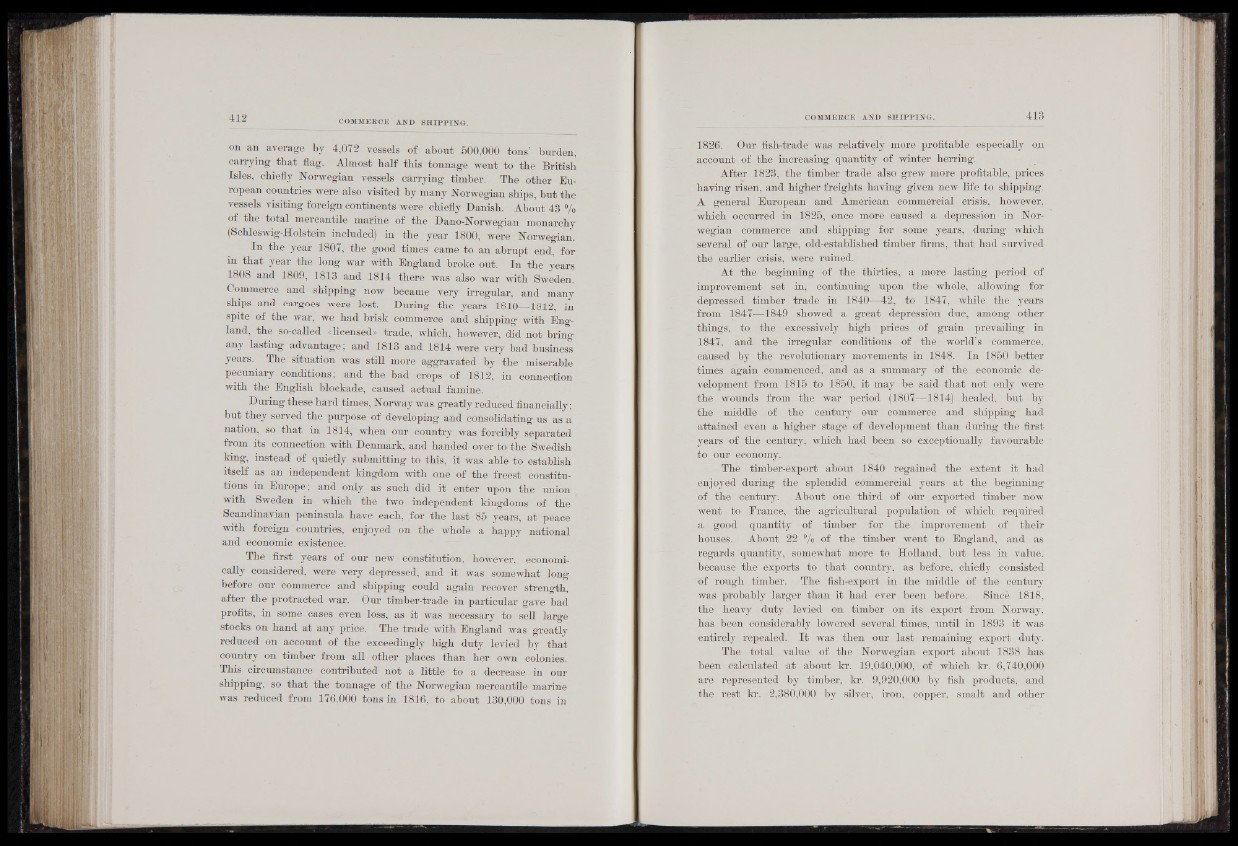
on an average by 4,072 vessels of about 500,000 tons’ burden,
carrying that flag. Almost half this tonnage went to the British
Isles, chiefly Norwegian vessels carrying timber. The other European
countries were also visited by many Norwegian ships, but the
vessels visiting foreign continents were chiefly Danish. About 43 %
of the total mercantile marine of the Dano-Norwegian monarchy
(Schleswig-Holstein included) in the year 1800, were Norwegian.
In the year 1807, the good times came to an abrupt end, for
in that year the long war with England broke out. In the years
1808 and 1809, 1813 and 1814 there was also war with Sweden.
Commerce and shipping now became very irregular, and many
ships and cargoes were' lost. During the years 1810—1812, in
spite of the war, we had brisk commerce and shipping with England,
the so-called «licensed» trade, which, however, did not bring
any lasting advantage; and 1813 and 1814 were very bad business
years. The situation was still more aggravated by the miserable
pecuniary conditions; and the bad crops of 1812, in connection
with the English blockade, caused actual famine.
During these hard times, Norway was greatly reduced financially;
but they served the purpose of developing and consolidating us as a
nation, so that in 1814, when our country was forcibly separated
from its connection with Denmark, and handed over to the Swedish
king, instead of quietly submitting to this, it was able to establish
itself as an independent kingdom with one of the freest constitutions
in Europe; and only as such did it enter upon the union
with Sweden in which the two independent kingdoms of the
Scandinavian peninsula have each, for the last 85 years, at peace
with foreign countries, enjoyed on the whole a happy national
and economic existence.
The first years of our new constitution, however, economically
considered, were very depressed, and it was somewhat long
before our commerce and shipping could again recover strength,
after the protracted war. Our timber-trade in particular gave bad
profits, in some cases even loss, as it was necessary to sell large
stocks on hand at any price. The trade with England was greatly
reduced on account of the exceedingly high duly levied by that
country on timber from all other places than her own colonies.
This circumstance contributed not a little to a decrease in our
shipping, so that the tonnage of the Norwegian mercantile marine
was reduced from 176,000 tons in 1816, to about 130,000 tons in
1826. Our fish-trade was relatively more profitable especially on
account of the increasing quantity of winter herring.
After 1823, the timber trade also grew more profitable, prices
having risen, and higher freights having given new life to shipping.
A general European and American commercial crisis, however,
which occurred in 1825, once more caused a depression in Norwegian
commerce and shipping for some years, during which
several of our large, old-established timber firms, that had survived
the earlier crisis, were ruined.
At the beginning of the thirties, a more lasting period of
improvement set in, continuing upon the whole, allowing for
depressed timber trade in 1840—42, to 1847, while the years
from 1847—1849 showed a great depression due, among other
things, to the excessively high prices of grain prevailing in
1847, and the irregular conditions of the world’s commerce,
caused by the revolutionary movements in 1848. In 1850 better
times again commenced, and as a summary of the economic development
from 1815 to 1850, it may be said that not only were
the wounds from the war period (1807—1814) healed, but by
the middle of the century our commerce and shipping had
attained even a higher stage of development than during the first
years of thè century, which had been so exceptionally favourable
to our economy.
The timber-export about 1840 regained the extent it had
enjoyed during the splendid commercial years at the beginning
of the century. About one third of oiir exported timber now
went to France, the agricultural population of which required
a good quantity of timber for the improvement of their
houses. About 22 % of the timber went to England, and as
regards quantity, somewhat more to Holland, but less in value,
because the exports to that country, as before, chiefly consisted
of rough timber. The fish-export in the middle of the century
was probably larger than it had ever been before. Since 1818,
the heavy duty levied on timber on its export from Norway,
has been considerably lowered several times, until in 1893 it was
entirely repealed. I t was then our last remaining export duty.
The total value of the Norwegian export about 1838 has
been calculated at about kr. 19,040,000, of which kr. 6,740,000
are represented by timber, kr. 9,920,000 by fish products, and
the rest kr. 2,380,000 by silver, iron, copper, smalt and other